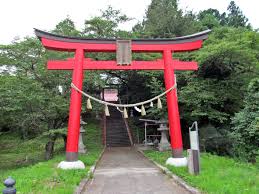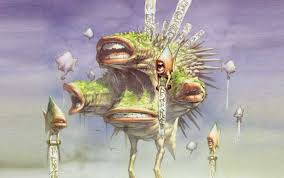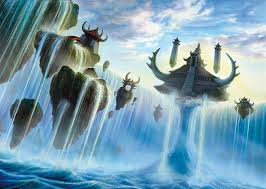Thanks to this week’s Uncharted Realms, republished in anticipation of Modern Masters 2, we’re back on Kamigawa!
Land of the Gods
The plane of Kamigawa, released in the block of the same name back in 2004-2005, clearly draws from Japanese culture, history, and folklore. The crux of the plot focused upon conflict between the sapient species of the world and the omnipresent kami, gods of natural forces that existed throughout the plane.
Like the elementals and Temur shamanism on Tarkir, the spiritual elements of Kamigawa make reference to polytheistic religious practice here on Earth. Kami, the gods and spirits of the plane, are a direct transliteration of the kami of Japanese ritual practice and belief embodied in Shintoism.

The torii gate – symbol of the Champions of Kamigawa set – marks the entryway of Shinto temples and the line between temporal and spiritual worlds.
The indigenous Japanese faith of Shinto reveres a pantheon of gods responsible for the forces of the natural world. First compiled in written form in the 8th century CE, Shintoism is maintained through ritual observance of natural cycles and spirits, ceremonial purification of oneself, and visitation and due respect to shrines, whether as personal as a household shelf or as grand as Shinto’s most impressive temples in Japan today. Like the shamanism described in our visit to Tarkir, Shintoism does not possess a central text, orthodoxy of practice, or universally observed hierarchy and religious law.1 It is instead a belief structure born of willing reverence of natural kami, native and extremely influential to the history and culture of Japan.
All of the other factions and cultures of Kamigawa owe their inspiration to Japanese history, religion, and folklore, in one form or another. Some, like the plane’s white-aligned fox-people Kitsune, directly reference a feature of Japanese mythology, while others like the blue-aligned Soratami moonfolk likely draw from a few sources (including legends of people who lived on the moon or in the heavens, appearing on Earth in celestial chariots) to create a culture unique to Kamigawa. The akki, like Kiki-Jiki of this week’s Uncharted Realms, are a direct transliteration with a twist. Where they are described as grotesque humanoid demons in Japanese folklore, they appear on Kamigawa with short stature, long noses, and (at least in Kiki-Jiki’s case) a propensity for mischief; all features of imp-like tengu in Japanese belief.
All of the factions of Kamigawa owe their inspiration to Japanese history, religion, and folklore.
The humans of Kamigawa reference Japanese culture and civilization throughout the feudal era of its history, from the structure of its religion and scholarship to its military and social hierarchy. The omnipresent samurai creature type of the set refers to the Japanese nobility who formed the social and military elite of the pre-national landscape of the medieval period. Samurai represented not only a martial tradition, but a whole societal organization, in which noble bloodline and formalized behavior separated them from castes of peasants and craftspeople. The morals emphasized throughout Kamigawa’s samurai – duty, discipline, ferocity in battle, fealty to one’s lord – were the attributes most prized in Japanese warrior culture (and, arguably, other military/social elites worldwide) throughout the feudal era up to the late 19th century.
Planes Past and Present
Kamigawa, like Tarkir, pulled from a rich source of history and culture to create a plane unique within the multiverse. It referenced and occasionally directly used elements of eastern Asian religion to populate its world, as did Tarkir with its rakshasa and naga. In other cases, like the moonfolk and akki, new and adapted cultural elements were created for Magic’s multiverse.
So why do we recall it so poorly?
Kamigawa consistently ranks with Mercadia (and sometimes Lorwyn) as the least-enjoyed plane by modern fans of the game. Mark Rosewater discusses the block as partially mistaken in his podcast series and on his blog.
Certainly as I wrote about Tarkir, I felt relieved that it wasn’t “just another Kamigawa.” I felt that the folks at Wizards of the Coast had done good work in representing central Asian cultures in the medieval era with respect and detail. Upon reflection, and revisiting some of the design documents that describe the process of making Kamigawa, I think what I disliked most was not the depiction of Japanese culture and society in the feudal era, but some of the mechanical and set composition decisions that went into the block.
Kamigawa consistently ranks with Mercadia (and sometimes Lorwyn) as the least-enjoyed plane by modern fans of the game.
The set composition always stands out to me, both in the era of playing Kamigawa casually and now looking back. Like Tarkir and its dragons, Kamigawa was designed around a flagship creature type: the newly-redesigned Legendary designation. But the raw numbers of Legends running around Kamigawa are awe-inspiring. There are more Legendary Creatures in Saviors of Kamigawa than Dragon creatures in Dragons of Tarkir, despite the fact that the more recent set outnumbers Saviors, 264 cards to 165! With so many Legendary Spirits, Samurai, and others, it seems likely that the audience was over-saturated with Kamigawa’s notables, not to mention the tournament difficulty of playing Legendary creatures before the rules change that applied the Legend rule on each side of the board separately.
Kamigawa was also sandwiched between two sets that defined modern Magic: Mirrodin and Ravnica. Both are sets that have proven so popular that they have spawned returns and major plot developments in the main storyline of Magic. Kamigawa’s neglect by comparison seems inevitable.
There are more Legendary creatures in Saviors of Kamigawa than Dragon creatures in Dragons of Tarkir.
But more than anything else, we can look to Tarkir to see some of the lessons learned from Kamigawa. Tarkir drew from historical content across an entire continent, from frigid tundras to humid jungles, to create a believable and diverse world. It focused on Khans, as did Kamigawa with Japan, but it expanded that focus to include cultural influences beyond simple depiction of Chinggis Khan’s armies and the tribes of the steppes. And finally, the fiction set on Tarkir has been presented online and in cards more consistently than it was in the era of Kamigawa. It is much easier to immerse oneself in the world of the planes and the lives of the planeswalkers today, with story presented in cards like Fate Forgotten, Sorin’s Revelation, and Sarkhan’s Triumph. I enjoyed this look back at Kamigawa in this week’s Uncharted Realms, for the historical content but also for the reminder of just how much work has gone into the game we love!
Until the release of Modern Masters II and the spoilers for Magic: Origins, I will be writing in response to content put out by the Uncharted Realms column. See you next week!
1 Many Japanese Shintoists revere Japan’s imperial family as both spiritual and temporal figures of authority, as they possess divine lineage back to the foundation of the nation.



